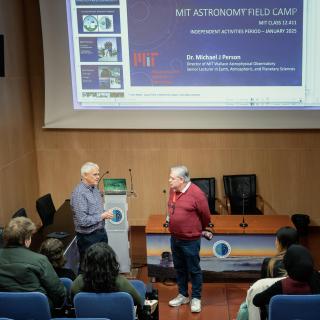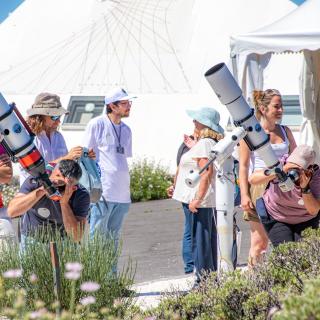It may interest you
-
 This January, the Instituto de Astrofísica de Canarias is hosting, for the third time, the ‘ MIT Astronomy Field Camp’, the historic scientific camp that the Massachusetts Institute of Technology (MIT) offers to its students of planetary sciences and astronomy with the aim of providing them with the real experience of working in a professional observatory. On this occasion, nine students have been at the Teide Observatory, in Tenerife, since 7th January, where they have carried out various astronomical observations. Dr. Michael Person has been the coordinator of this activity that began inAdvertised on
This January, the Instituto de Astrofísica de Canarias is hosting, for the third time, the ‘ MIT Astronomy Field Camp’, the historic scientific camp that the Massachusetts Institute of Technology (MIT) offers to its students of planetary sciences and astronomy with the aim of providing them with the real experience of working in a professional observatory. On this occasion, nine students have been at the Teide Observatory, in Tenerife, since 7th January, where they have carried out various astronomical observations. Dr. Michael Person has been the coordinator of this activity that began inAdvertised on -
 Cristina Ramos Almeida, investigadora del Instituto Astrofísico de Canarias (IAC) y coautora de más de un centenar de artículos sobre galaxias y agujeros negros, ha sido una de las homenajeadas en la primera edición de los premios "Mujeres tenían que SER" de Radio Club Tenerife, Cadena SER. El evento, celebrado en la noche del miércoles 29 de octubre, en la sala Adán Martín del edificio de Presidencia del Gobierno en Santa Cruz de Tenerife, ha teñido el espacio de reconocimiento al talento femenino en diversos ámbitos. La distinción resalta la crucial contribución de Ramos Almeida a laAdvertised on
Cristina Ramos Almeida, investigadora del Instituto Astrofísico de Canarias (IAC) y coautora de más de un centenar de artículos sobre galaxias y agujeros negros, ha sido una de las homenajeadas en la primera edición de los premios "Mujeres tenían que SER" de Radio Club Tenerife, Cadena SER. El evento, celebrado en la noche del miércoles 29 de octubre, en la sala Adán Martín del edificio de Presidencia del Gobierno en Santa Cruz de Tenerife, ha teñido el espacio de reconocimiento al talento femenino en diversos ámbitos. La distinción resalta la crucial contribución de Ramos Almeida a laAdvertised on -
 El Observatorio del Teide recibe este fin de semana a cerca de 1.000 visitantes en sus tradicionales Jornadas de Puertas Abiertas, organizadas por el Instituto de Astrofísica de Canarias (IAC) con motivo del solsticio de verano. Esta iniciativa, ya consolidada en el calendario divulgativo del IAC, ofrece a la ciudadanía la oportunidad de acercarse a la ciencia y a las infraestructuras científicas de Canarias de forma directa y cercana. La actividad está coordinada conjuntamente por el propio Observatorio y por la Unidad de Comunicación y Cultura Científica (UC3) del IAC, en el marco de lasAdvertised on
El Observatorio del Teide recibe este fin de semana a cerca de 1.000 visitantes en sus tradicionales Jornadas de Puertas Abiertas, organizadas por el Instituto de Astrofísica de Canarias (IAC) con motivo del solsticio de verano. Esta iniciativa, ya consolidada en el calendario divulgativo del IAC, ofrece a la ciudadanía la oportunidad de acercarse a la ciencia y a las infraestructuras científicas de Canarias de forma directa y cercana. La actividad está coordinada conjuntamente por el propio Observatorio y por la Unidad de Comunicación y Cultura Científica (UC3) del IAC, en el marco de lasAdvertised on